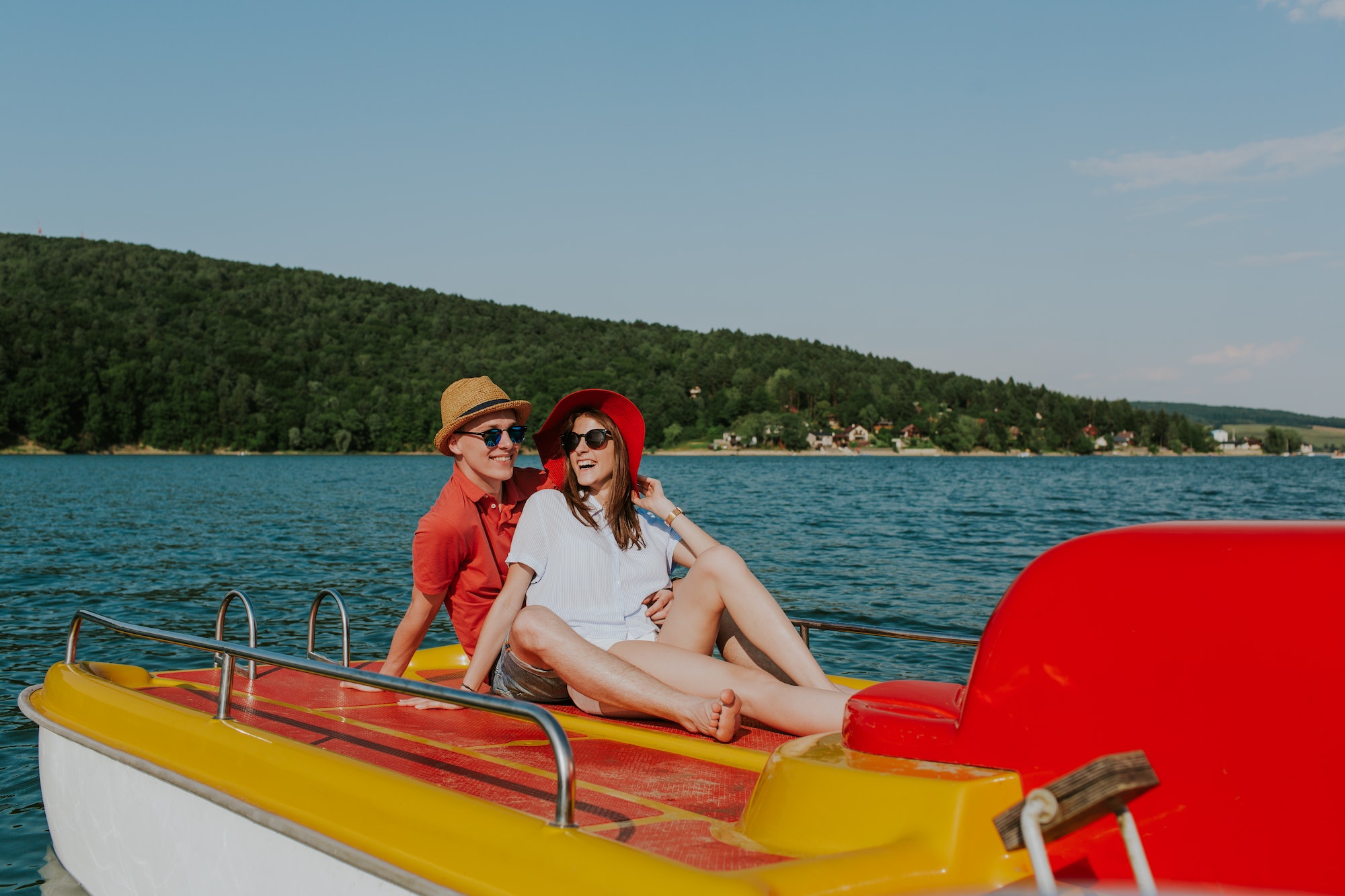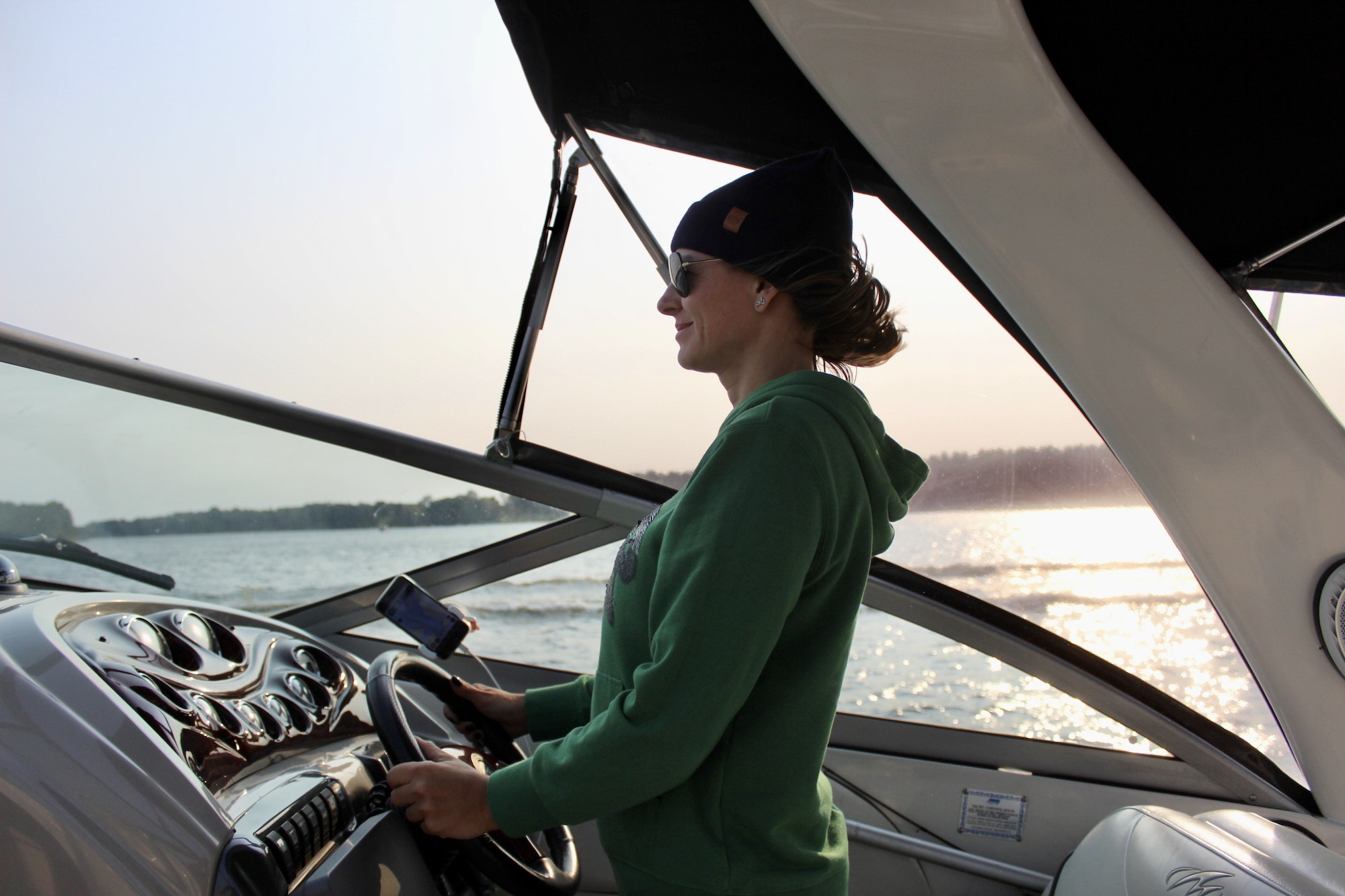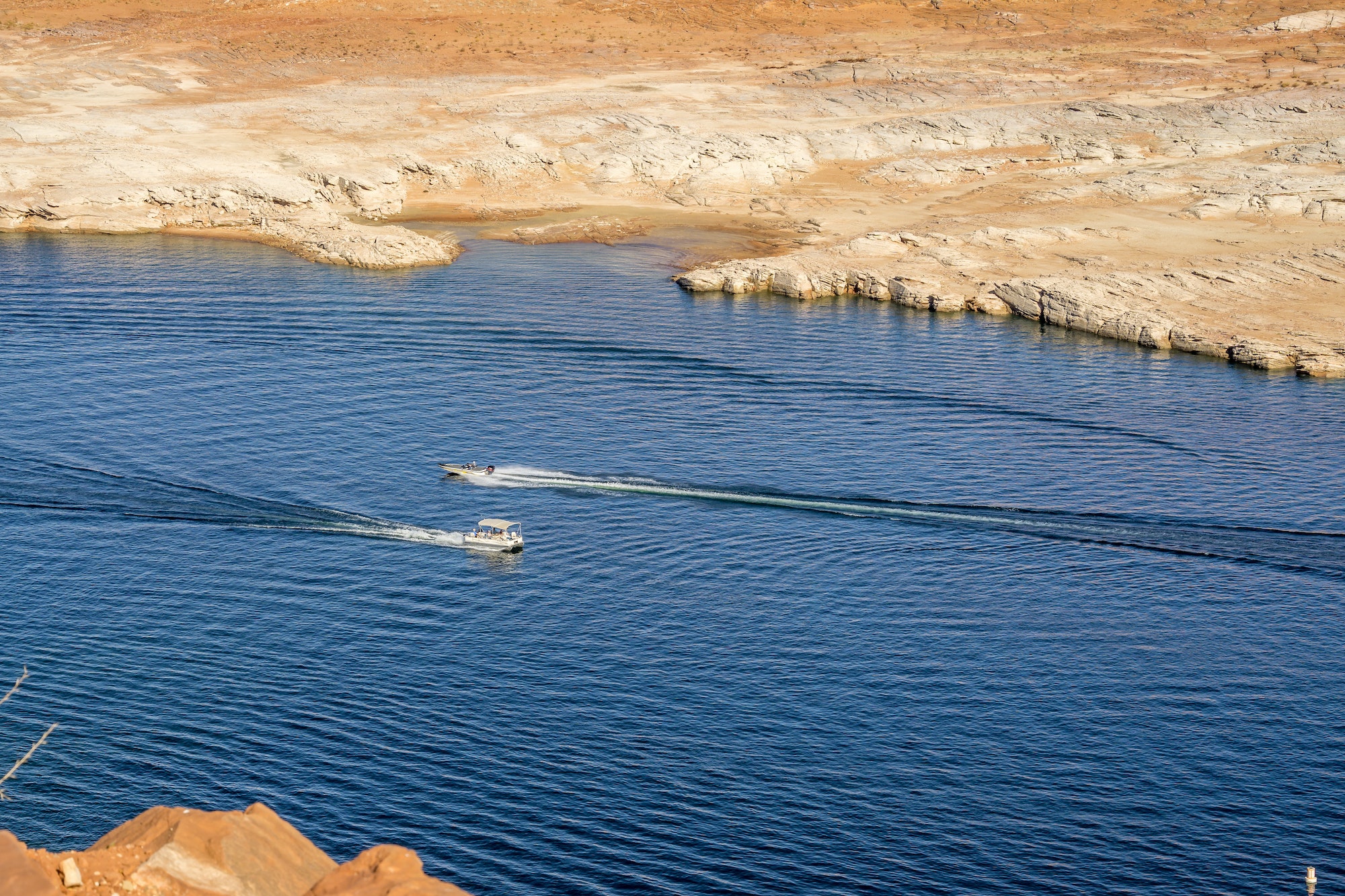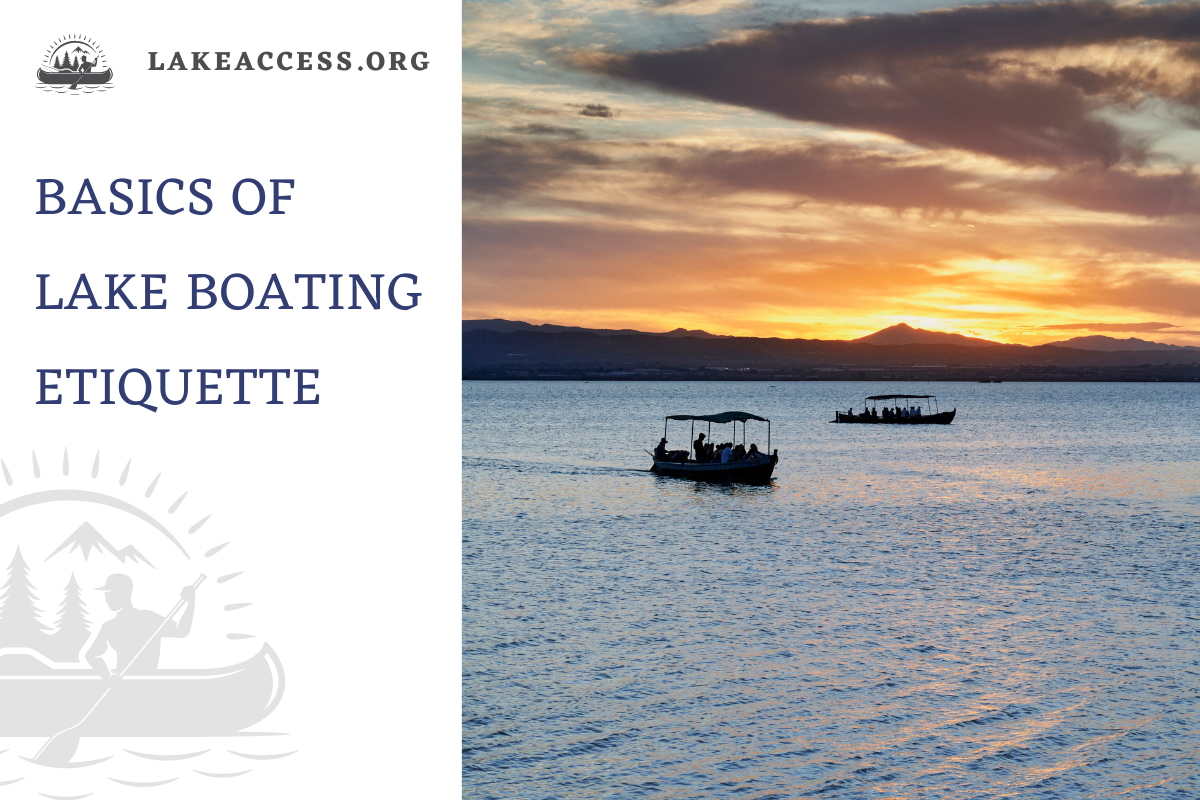Lake boating is a great way to enjoy the outdoors, relax, and spend time with family and friends. But just like any other activity, specific etiquette rules should be followed to ensure everyone has a safe and enjoyable experience.
Here are some of the basics of lake boating etiquette:
Lake Boating Etiquette
Keep a safe distance
Maintaining a safe distance from other boaters on a lake is essential for several reasons, including avoiding collisions, reducing wake interference, and respecting personal space. A good rule of thumb is to keep a distance of at least 100 feet from other boats. This distance can vary depending on the size and speed of the boats, as well as the water conditions. In a crowded area or busy waterway, it is best to maintain an even greater distance to maximize safety.
Respect the no-wake zones
When vessels pass one another while on a lake, it is essential to be aware of any no-wake zones in the vicinity. All watercraft should be operated at a speed of 5 miles per hour or less while within a no-wake zone. To do this, shift the boat into the lowest gear and allow it to idle until clear of the no-wake zone. When vessels are not in a no-wake zone, they should pass one another safely by ensuring sufficient clearance. It is recommended to give vessels the right of way and ensure that the boat stays a safe distance from the other vessel (minimum of 100 feet). As the boat captain, it is essential to be aware of the boat’s speed and the size of the waves being made, which can cause damage or disruption to other vessels in the area. To pass safely, boat captains should follow the general rule of keeping their boat speed and wake size to a minimum.
Use proper lighting
Proper lighting on a boat is essential for improved visibility, especially during nighttime or low-light conditions. Navigation lights are crucial as they help other boats identify your boat’s size, shape, and direction. In addition, they help you see any water hazards, such as rocks, buoys, or other boats, so you can avoid them.
Proper lighting not only enhances safety but also improves the appearance of your boat. This can be especially useful when entertaining guests on your boat, making it more enjoyable for everyone. You can use different types of lighting, such as LED lights, to create a warm and welcoming atmosphere.
Boats, like cars, are subject to laws and regulations. Failure to comply with these regulations can result in fines, penalties, or even legal action. In many countries, it is a legal requirement to have proper lighting on your boat.
Follow the speed limit
Following the speed limit while lake boating is essential for several reasons. Excessive speed is a leading cause of boating accidents and can put yourself and others at risk. Additionally, high speeds can create large waves that erode shorelines and damage natural habitats, which can have a negative impact on the environment. Furthermore, boating at excessive speeds can result in fines and penalties, so familiarize yourself with the speed limits on the lake you plan to boat on. By following the speed limit, you can help ensure the safety of yourself and others, protect the environment, and avoid any legal penalties. Always remember to prioritize safety while on the water and to respect the natural beauty of the lake you are boating on.
Be aware of fishing areas
When lake boating, it’s essential to know the different fishing areas. These are typically divided according to specific rules and regulations, such as those regarding size and fish species. Additionally, it’s essential to adhere to the designated “no wake” areas and observe any speed limits. Areas of the lake to be aware of include shallow waters, deep water, river mouths, drop-offs, and any areas designated as spawning or nursery grounds. When fishing in any of these areas, it’s essential to be mindful of any local laws or regulations that may apply. By following these rules and guidelines, you can ensure safe and enjoyable lake boating for everyone.
Respect the environment
Respecting the environment is essential when boating to preserve the natural beauty of the lake and its surroundings, minimize the negative impact on the ecosystem and wildlife and leave no trace from your visit. Excessive speed, loud noises, and pollution from boats can all harm the lake’s wildlife and ecosystem, so it’s essential to be mindful of your impact. Additionally, it’s important to properly dispose of any waste or trash while boating to avoid littering. By being a responsible boater and following the Leave No Trace principles, you can help to ensure that the lake remains a beautiful and enjoyable place for everyone to visit.
Follow the Rules
- Travel on the right side of the water, the same way American drivers would travel on the road.
- Slow down and pass with caution when approaching other boats or water vessels.
- When in doubt, give the right of way to the boat on the right side.
- Stay aware of your surroundings and be prepared to make sudden changes in direction.
- Follow any navigation markers or buoys that are present.
- Stay alert and avoid areas where there are large numbers of other boats.
- May different types of water vessels have different speed limits. Check the posted speed limit for the area before operating your boat.
- Yield to fishing vessels that have their lines in the water.
- If you are operating a powerboat, be aware of sailboats and other slow-moving vessels.
- Make sure all lights and navigation equipment are in working order.
Respect the Wildlife and Environment
When lake boating, it’s important to keep wildlife conservation in mind. To ensure that all wildlife is respected and kept safe, there are a few guidelines to consider:
- Do not disturb or harm any wildlife. This includes not touching or feeding any animals, as this can cause them harm or change their behavior.
- Drive your boat responsibly. This means observing speed limits, keeping a safe distance from wildlife, and avoiding shallow waters where wildlife may be present.
- Be aware of the environment. Be aware of any potential areas of disturbance, such as shorelines or nesting grounds.
- Follow all laws and regulations. Adhere to all local and state laws when it comes to the protection of wildlife.
Following these guidelines and practicing responsible boating will help ensure that wildlife can be enjoyed and respected properly.
Respect private property
Respecting private property while boating is important because it shows courtesy to the other boaters and the environment. Not only can careless boating damage another boat or someone’s property along the shoreline, but throwing trash in the water can also be detrimental to the environment. Boaters should take the time to familiarize themselves with the proper navigation rules, such as knowing the speed limit and following the waterway markers. Additionally, boaters should always ask permission before lighting up on someone’s boat, and they should keep the music at a decent level and not throw their butts in the water. Following these guidelines will help to ensure that everyone has a safe, enjoyable experience on the water.
Don’t drink and boat
You should never drink alcohol or take drugs and operate a boat. Boating under the influence is not only dangerous, but it is also illegal in all 50 states. Boating While Intoxicated (BWI) is the number one factor leading to boating accidents. Drinking and operating a boat can lead to serious injury and even death. In addition, alcohol impairs judgment and reaction time, making it more difficult to make quick decisions in an emergency. Even if you are not driving the boat, drinking alcohol on the boat can still put you and your fellow passengers at risk.
Furthermore, alcohol can cause dehydration, leading to fatigue and making it difficult to stay alert while operating the boat. Lastly, alcohol in the sun can heighten its effects and cause dizziness, nausea, and headaches. To ensure a safe and enjoyable time while boating, always remembers to designate a sober driver and always wear a life jacket.

What to consider when boating on a lake
Weather conditions
When boating on a lake, weather conditions to consider include wind direction and speed, temperature, wave heights, visibility, and cloud cover. Knowing which direction the wind is blowing is essential in determining the direction the boat will travel. The wind speed can also be a factor in whether or not the boat will remain on course. Temperature can affect the comfort level of passengers and operators, as well as the operating conditions of the boat. Wave heights should be considered when considering the boat’s stability. Visibility can be impaired by fog, rain, or other factors, so it’s essential to be aware of the conditions in the area. Lastly, cloud cover should be monitored to determine if rain is likely. Having a plan in case of bad weather is also a good idea.
Safety equipment
Having proper safety equipment is vitally important when boating on a lake. Safety should always be your top priority. Ensure everyone on the boat is wearing life jackets and knows how to use them. Even if you are a skilled boater, you should still sign the family up for a water safety course so everyone can be trained to respond to any aquatic emergency. You should also never operate a boat or any other water vessel after consuming drugs or alcohol.
It is also important to be aware of the rules and regulations of the lake you are boating on. This includes knowing the rules of the road, safety precautions, laws, and what to do in an emergency. As the captain of your vessel, you are responsible for ensuring everyone on board understands the necessary safety rules. You should also be considerate of other boaters on the lake and follow any unwritten rules, such as designated no-wake or slow-wake swimming areas.
Wildlife and wildlife habitat
When boating on a lake, it is essential to consider the wildlife and habitat that could be affected. This includes aquatic plants, fish, other aquatic habitats, shoreline vegetation, bird nesting areas, wetlands, and other habitats. All of these should be taken into account when observing no wake zones and speed limits, as these regulations are in place to protect these habitats from damage caused by large wakes. Additionally, it is essential to be mindful of your surroundings and not to cause any unnecessary damage to property or natural resources.

Rules for passing other boats on the water
When passing other boats on the water, it is important to make sure everyone’s safety is taken into consideration. To do so, give plenty of space to the other boat when passing, and make sure to communicate your intentions to them if possible. It is also essential to pass on the left-hand side, as this will help minimize the impact of your wake and make it easier for the other boat to maintain control. It is also recommended to slow down to a safe speed when passing another boat, as this will provide you with extra time to react if something unexpected happens. Lastly, be sure to remain aware of your surroundings, including any other boats, obstacles, and potential hazards that may be present in the area. Following these guidelines will help to ensure a safe and enjoyable experience for everyone on the water.

FAQ
How should I launch my boat from the dock or boat ramp?
Before you launch, make sure to prepare your boat in advance. Untie any ropes, load any gear and food, ensure the plug is in, and have the engine ready. To avoid clogging up the ramp, do all of this outside of the launch line. Once you are in line at the boat ramp, be as efficient as possible. Everyone wants to enjoy a day on the water; long lines can irritate. When it is your turn, quickly launch your boat. Once in the water, move away from the ramp to allow others to launch. When refueling, make space for the next boat once you have finished.
What are the rules for docking my boat in a marina?
When approaching the marina, reduce your speed to minimize the wake and abide by any posted speed limits. As you approach the marina, be aware of other boats in the area and maintain a safe distance. When entering the marina, check to ensure that the dock is clear of any other vessels and that there are no obstructions. When docking, have a spotter on the dock to help you. Have someone aboard the boat to help with lines and fenders if needed.
Securely tie the boat to the dock using the appropriate lines and fenders. After refueling or loading your boat, move to a temporary docking station and park if you need to go inside for groceries or other items. Don’t keep others waiting while you take care of business. When undocking, ensure that all lines and fenders are removed and stored safely. When leaving the marina, be aware of the other boats and follow the speed limit posted.
How should I anchor my boat in an anchorage area?
Approach the anchorage area at a low speed. Determine the swing radius of the first boat in the anchorage. Check the wind direction and adjust your position accordingly. Drop your anchor in the designated area, allowing enough lines to reach the bottom. Pay out the anchor line until it is taut. Using a cleat or winch, secure the anchor line to the boat. If necessary, set a second anchor to improve stability.
What is the etiquette when approaching a skier, swimmer, or other watercraft?
When approaching a skier, swimmer, or other watercraft, it is essential to exercise caution and follow proper boating etiquette.
Slow your speed and create a wide berth (at least 200 feet) around the person or vessel.
Never cut off another boat or skier.
Follow the waterway navigation rules and give other boaters and swimmers right-of-way.
Use appropriate signals to alert others of your presence.
Avoid creating a wake that could cause damage to swimmers or other vessels.
What navigation rules should I be aware of when boating on a lake?
When boating on a lake, there are certain navigation rules that you should be aware of in order to ensure the safety of yourself and all other passengers. These rules include the following:
Always stay in designated areas – Respect the local boating regulations and stay in the designated areas for your lake.
Obey all speed limits – Respect the lake speed limit and maintain a safe speed.
Give way to other boats – When two boats are on a collision course, the boat on the starboard (right) side must give way, while the boat on the port (left) side should maintain its course.
Follow all buoys – Buoys are marked areas used to indicate restrictions and navigational paths.
Follow the rules of the road – When in congested areas, prioritize the safety of other boaters.
Keep a lookout – Always keep an eye on the water around you, and pay attention to any other boats that may be in your area.
Be courteous to others – Be respectful to all other boaters, and don’t be afraid to speak up if someone is not following the rules.
By following these general navigation rules and safety tips, you can be confident and enjoy a safe boating experience.

